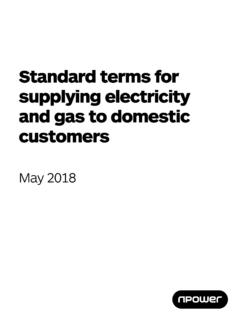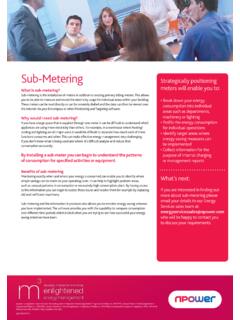Transcription of Understanding your gas bill - npower.com
1 Here s howwe work out your billsUnderstandMake sense of our credit meter tariffs with different unit ratesFairSee how all our customers paya fair share of fixed costsExampleUse our worked example to seehow we calculate your gas billFairSome of our credit meter tariffs (and all our prepayment tariffs) have a daily standing chargethathelps to cover the fixed costs we have to pay in supplying energy to you, distribution andmetering costs. For our credit meter tariffs with no standing charge the money we collect throughthe primary unit rate goes towards these fixed costs. For gaswe charge more units at the primary unit rate during the winter months to reflect thefact that most customers use more gas in the winter. We believe this helps to make sure that allour customers pay a fair share towards the fixed costs of supplying energy, and customers whouse very little gas in the summer months won t be subsidised by other customers.
2 For electricitywe charge the primary rate units evenly throughout the year because electricityuse is more consistent across the ll charge you at the primary unit rate for the total number of primary units applicable for abilling period, as long as your total consumption is at least equal to the total allocation of primaryunits for that period, and regardless of your usage in the individual months in that period. Here s an example. If we send you a bill for the period 1 July to 30 September, we ll aim tocharge a total of 138 primary rate units (46 units for each month). If no gas was used in oneof those months, but your gas consumption for the whole billing period was at least equal to138 units in total, then we ll charge 138 primary rate units on that bill . However, if you usedless than 138 units in that billing period, we won t carry forward any uncharged primary rateunits to the next billing of our credit meter tariffshave two rates for the unitsof gas and electricity you use (also called kilowatt hours or kWh): Primaryunit rates (labelled as first on your bill ) are charged at a higher rate Secondaryunit rates (labelled as next on your bill ) are charged at a cheaper rateThe primary rate units are applied to individual billing periods ( the periods reflected in your bills) as follows: For electricitythe primary rate units are charged evenly through the year at (or units) per month (that s about 2 units a day), adding up to a maximum of 728 units a year.
3 For gasthe primary rate units are charged on a seasonally adjusted basis, with more primaryunits being charged in the winter months, adding up to a maximum of 4572 units a year asshown in this table:MonthsMaximum units charged at primary rate per monthMaximum percentage charged at primary rate per monthNov, Dec, Jan, , , June, July, Aug, total4572If you were previously on our Tracker, Fixed Price 2009 or Sign Online 8 gas tariffs your primary rate gas units are allocated differently across the months you canfind out more at or call Customer the total for the middle months is out the last month s % at the primary rateTake the last day of the bill and divide by the number of days in the last month (June = 30 days)14 / 30= by the percentage for that month (as shown in the table opposite)
4 And round to 2 decimal x = the last month s proportion of the 4572 units charged at the primary rate is calculate the total percentage to be charged at the primary rate for this billAdd all percentages + + = the total percentage by 4572 and round up to a whole number, to get the units charged at the primary / 100 x 4572 = 479So the total number of units charged at the primary rate is 479 Step 3 - Work out the total billLet s assume our prices are primary rate per unit and secondary rate per unit Take the number of units at the primary rate (from Step 2) and multiply by the primary rate,then divide by 100 to convert into pounds and pence:479 x / 100 = the total units (from Step 1) and subtract the number of units charged at the primary rate (from Step 2) to get the number of units charged at the secondary 479 = this number of units at the secondary rate and multiply by the secondary rate, then divide by 100 to convert into pounds and x / 100 = these two together: + = multiply by to add VAT at 5%: x = the total bill including VAT is out the middle months % at the primary rateUse the full percentage for each full month (as shown in the table opposite) Second month (April) = month (May) = + = 1 Work out how many units you ve usedSubtract your previous meter readingfrom your current meter readingto work out the volume of gas used.
5 If you have an imperial meter that measures your gas in cubic feet (with 4 dials),multiply this number by to convert to cubic you have a metric meter (with 5 dials) there s no need to do multiply this number by the Calorific Value and the Correction Factor, and then divide by (round the answer to 1 decimal place) to give you the total units (kWh) charged on the can find the values for Calorific Valueand Correction Factor on your bills. Thesefigures can vary but are approximately:Calorific Value Factor s assume your previous meter reading is 48400 and your current meter reading is 48800So the volume of gas used is:48800 48400 = 400 Multiply by the Calorific Value:400 x 40 = 16000 Multiply by the Correction Factor:16000 x = by / = unitsSo the amount of gas used is unitsStep 2 - Work out the number of units to be charged at the primaryand secondary rateThe primary units will be allocated as shown in the table opposite.
6 Any remaining units will becharged at the secondary s assume the three-month bill period is 15 March to 14 JuneWork out the first month s % at the primary rateTake the number of days in the first month and subtract the start day of the bill (March = 31 days)31 - 15 = 16 Divide the answer by the number of days in the month:16 / 31 = by the percentage for that month (as shown in the table opposite ) and round to 2 decimal x = the first month s proportion of the 4,572 units charged at the primary rate is calls: We may monitor and/or record calls for security, quality or training purposes. Calls from BT landlines to numbers beginning with 0845 may be free. The price of calls may vary with other operators and calls from mobiles may be considerably higher.
7 Please check with your operator for exact is a registered trademark and the trading name of Npower Limited (Registered No. 3653277), Npower Gas Limited (Registered No. 2999919), NpowerNorthern Limited (Registered No. 3432100) who also act as an agent for Npower Northern Supply Limited (Registered No. 2845740) for the supply of electricity,Npower Yorkshire Limited (Registered No. 3937808) who also act as an agent for Npower Yorkshire Supply Limited (Registered No. 4212116) for the supply ofelectricity. Registered in England and Wales. Registered Office: Windmill Hill Business Park, Whitehill Way, Swindon SN5 questions?Our top tips to help you be more energyefficient and caring for the you still have any questions, why not try looking for an answer on our website at you can call one of our specialist Customer Service teams:Direct Debit0845 070 4851 Regular Payment Scheme0845 070 4852 Quarterly cash/cheque0845 070 4850 Please have your account number to hand when you re here to help you 8am to 8pm Monday to Friday and 8am to 6pm 1 Getting your boilerregularly serviced couldsave you 10-15% of yourenergy bills according tothe Carbon Trust.
8 Learnmore about npower sboiler service and careproducts at our 2 The Energy Saving Trustsays by turning down your thermostat by just 1 degree could reduce yourheating bills by up to 10%.Tip 3Do your bit for theenvironment, switch to paperless billing from all this and more just visit









